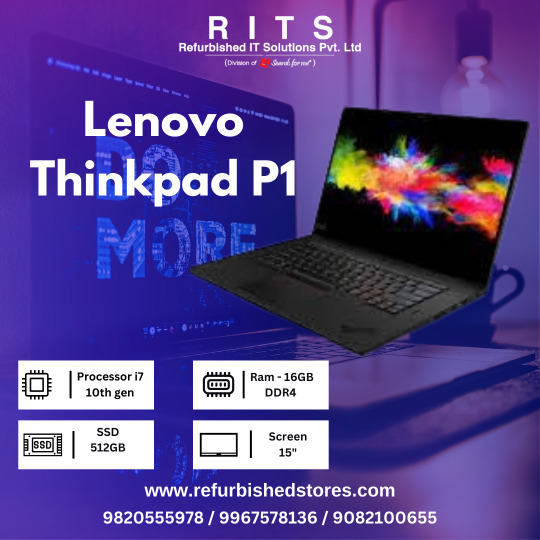#PowerfulWorkstation
Explore tagged Tumblr posts
Text
Lenovo ThinkPad P1: A Workstation Powerhouse for Professionals
The Lenovo ThinkPad P1 is a top-tier mobile workstation designed for professionals who demand high performance, portability, and reliability. It combines the power of a desktop workstation with the mobility of a laptop, making it a go-to device for engineers, designers, and content creators who need serious computing capabilities on the go.
Design and Build Quality
True to the ThinkPad lineage, the ThinkPad P1 retains Lenovo's signature durable and sleek design. The laptop features a carbon-fiber and magnesium alloy chassis, ensuring a lightweight yet robust build. Despite its rugged construction, the ThinkPad P1 maintains a slim profile at just 0.7 inches thick and weighs around 3.8 pounds, making it incredibly portable for such a powerful machine.
Display and Graphics
The ThinkPad P1 boasts a stunning 16-inch display with options for 4K UHD or Full HD resolutions, catering to professionals who need crystal-clear visuals. For designers and video editors, the laptop's color accuracy and brightness make it ideal for tasks that require precise detail.
Additionally, the ThinkPad P1 is equipped with NVIDIA RTX A-series graphics, offering incredible rendering power for 3D modeling, video editing, and other graphics-intensive applications. This makes it a great choice for creative professionals who rely on GPU-heavy software.
Performance
Under the hood, the ThinkPad P1 is powered by up to Intel Core i9 processors, paired with up to 64GB of RAM and 4TB of SSD storage. This powerhouse configuration ensures blazing-fast performance, whether you're handling massive datasets, running simulations, or multitasking between demanding applications.
With such a strong CPU-GPU combination, the ThinkPad P1 is optimized for software like AutoCAD, Adobe Premiere Pro, and other resource-intensive programs that require a workstation-class machine. Despite its high performance, the ThinkPad P1 manages heat effectively, thanks to Lenovo's advanced cooling system.
Security and Features
Lenovo has equipped the ThinkPad P1 with multiple security features, including a fingerprint scanner, IR camera with Windows Hello, and a TPM 2.0 chip for encrypted data protection. These ensure that sensitive data stays safe, making the laptop ideal for professionals handling confidential information.
The laptop also has a variety of connectivity options, including Thunderbolt 4, USB-C, HDMI, and an SD card reader, ensuring that you can connect to all your peripherals with ease.
Conclusion
The Lenovo ThinkPad P1 is a versatile, high-performance workstation that caters to the needs of professionals across various industries. Whether you're an engineer, content creator, or designer, the ThinkPad P1 delivers exceptional power in a sleek and portable form. It's a perfect blend of performance, portability, and durability for those who demand the best from their mobile workstation.

#ThinkPadP1#LenovoThinkPad#MobileWorkstation#HighPerformanceLaptop#ProfessionalLaptop#IntelCorei9#NVIDIARTX#DesignLaptop#PowerfulWorkstation#BusinessLaptop#CreativeProfessionals#LenovoWorkstation#ThinAndLightLaptop#WorkstationPowerhouse#PremiumLaptop#PortableWorkstation
0 notes
Text

Green tech pc builder: 5 tips for best custom pc build
Building a custom PC is an excellent way to get a high-performance computer that meets your specific needs. Whether you're a gamer, a graphic designer, or just looking for a powerful workstation, building a custom PC is a great way to get exactly what you need.
Here are five steps to help you build the best custom PC for your needs:
Step 1: Define your needs and budget The first step in building a custom PC is to determine what your needs are and how much you're willing to spend. Consider what you'll be using the PC for and what kind of performance you need. Make a list of the components you'll need, such as a CPU, motherboard, RAM, graphics card, and storage. Once you've identified your needs, research the prices of each component and determine a budget.
Step 2: Choose your components Once you've identified your needs and budget, it's time to choose the components for your custom PC. Look for components that offer good performance and value for your money. Research the various options for each component and choose ones that are compatible with each other.
Step 3: Assemble your PC Once you've chosen your components, it's time to assemble your PC. Begin by installing the CPU, RAM, and motherboard. Then, install the power supply and the graphics card. Finally, connect all the cables, including those for the power supply, fans, and other components.
Step 4: Install the operating system and software After you've assembled your PC, it's time to install the operating system and any software you need. Choose an operating system that's compatible with your hardware and install any drivers needed for your components. Install any software you'll be using, such as productivity software, games, or graphics applications.
Step 5: Test and optimize your PC Once you've installed your operating system and software, it's time to test and optimize your PC. Run benchmark tests to ensure that your PC is performing as expected. If you encounter any issues, troubleshoot them by checking your hardware and software settings. Finally, optimize your PC by adjusting your graphics settings, overclocking your CPU, and tweaking other settings to improve performance.
In conclusion, building a custom PC can be a fun and rewarding experience. By following these five steps, you can build the best custom PC for your needs and budget. Just remember to take your time, do your research, and choose components that offer good performance and value for your money.
#CustomPCBuild#PCMasterRace#BuildYourOwnPC#HighPerformancePC#GamingPC#OptimizedForYou#DIYPCBuild#PowerfulWorkstation
1 note
·
View note